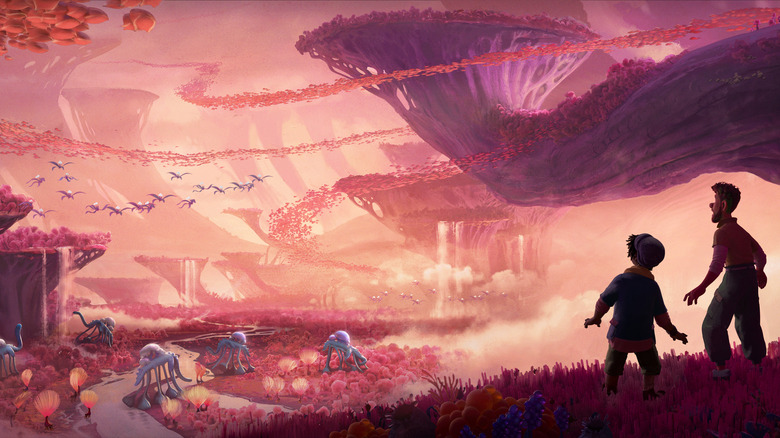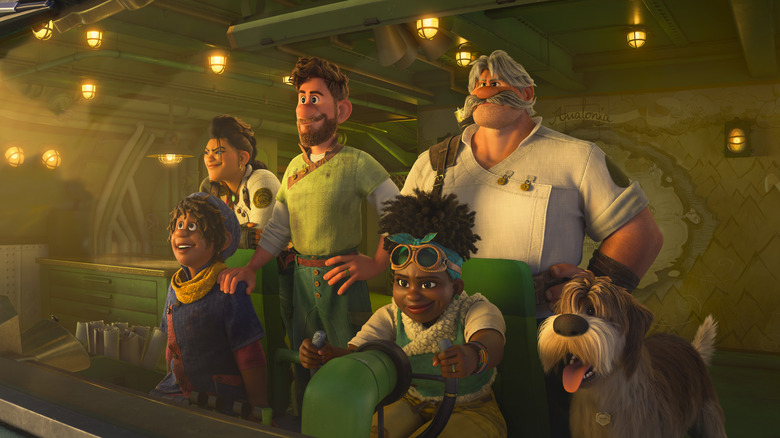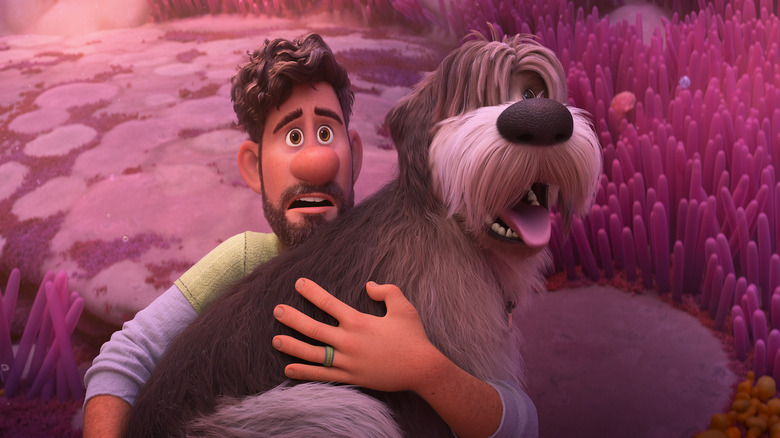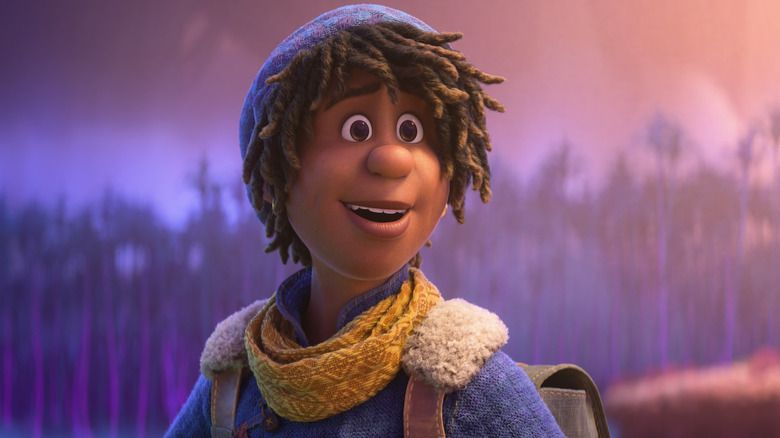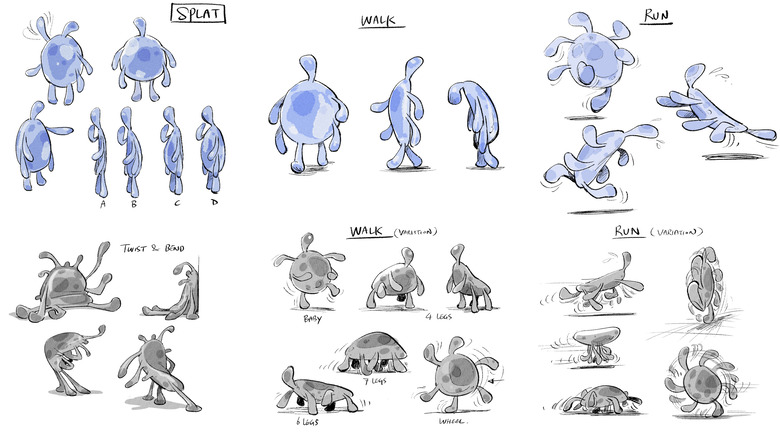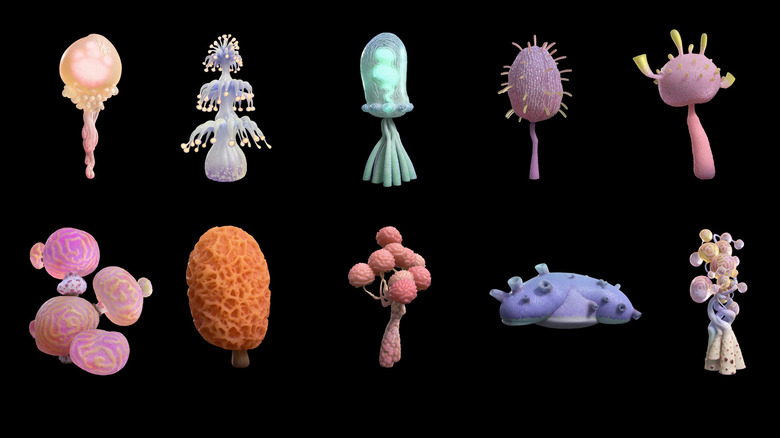Strange World Heads Of Animation Talk About 'Poop Pickles' And The Other Weird Creatures They Created [Exclusive Interview]
The upcoming Disney animated film "Strange World" lives up to its title. The world that the Clade family visits is, indeed, strange. And the creatures that inhabit that world are, if it's possible, even stranger.
Even though there's a lot of weirdness in the film, all of those odd creations are still relatable and, dare I say, even adorable at times. During a press event at Disney Animation Studios last week, I had the chance to sit down with "Strange World" Heads of Animation Amy Smeed and Justin Sklar to talk about their work on the film. We chatted about their approach to creating creatures unlike anything we've seen before (including the seven-legged Splat, who will undoubtedly become one of Disney's most beloved animal characters), but also how they approached crafting the plain ol' human characters in a way that fit with the rest of the film.
This interview has been edited and condensed for clarity.
'We were just chasing the idea of fun and then trying to put a structure around it'
I want to talk about creating the human characters, and how you mentioned you looked to both more recent films and also post-World War II films to give the characters a type of musicality. Could you speak a little bit more about those sources of inspiration and also if you looked anywhere to else to bring a pulp feel to the characters?
Justin Sklar: What's interesting about this film is that everyone was approaching it from a different direction. I think [director Don Hall and co-director and writer Qui Nguyen] had a very specific vision about how we're going to approach the pulp thing and that became something for Jin Kim, who was drawing the characters, because it became this kind of French comic thing — there's a little bit of Miyazaki in there and it wasn't really conceived as a late '40s, early '50s Disney thing.
A lot of what motivated the way that we animated came from six months of conversations with our animation supervisors, where every week we would each show something that we thought was cool. Don told us early on: "I want this to be fun. I want it to be fun to watch. I want it to be fun to animate." So we just watched stuff that was fun to animate. And we talked about why it was fun, and it's fun because they're making bigger, wilder choices.
It's also fun because it's playing with depth in the screen. I think that fits a little bit into the pulp vibe of it — there are some sequences where we lean into sort a comic book thing. And so it was there in the back of our minds, but honestly I feel like we were just chasing the idea of fun and then trying to put a structure around it.
'We also consider what the scene needs to communicate, and how much is this scene about them coming together versus coming apart'
One of the themes that's seemingly important through the movie are the father-son relationships. There are two here — Searcher and Ethan and Searcher and Jaeger — and I imagine there's a different dynamic between the two when they're talking with their respective fathers. For those scenes, how did you approach how those characters would react to each other?
Amy Smeed: We have a team of supervising animators for Ethan, Jaeger, and Searcher. They each have their own supervising animator and the three of them met and started talking about what mannerisms that all three of them have that are almost a part of them.
But Jaeger, for example, is very different from Searcher obviously. So what is going to separate them? Jaeger is very big and so the way he moves is very, very confident, which is very different than Searcher, who has his farm, and is, maybe not a perfectionist, but more into details. There's a lot of nuances to the performances that we bring to those characters.
Sklar: We tend to build a physicality and understand how those physicalities are different. That's why we did the things like the gate test [where each character does the same task in the same setting], which was something we stole from "Big Hero 6," because it's a really good way to understand how characters move differently. We take all of those differences that we've built, and we take the similarities that we've built, and then we put them up against what the dialogue is in the scene. We also consider what the scene needs to communicate, and how much is this scene about them coming together versus coming apart.
'He wants to be the perfect dad'
I imagine Searcher, for example, when he was talking to his dad, probably has some unresolved feelings.
Sklar: I think the biggest thread in the movie in this regard is that Searcher's relationship with his dad is not great and that his relationship with Ethan is great. But when you hear from Ethan's point of view, it's maybe slightly different than Searcher's view of things. Searcher's motivations throughout so much of the film are from the moment where his father abandoned him and how his life became about pushing away his father. But there's also a big draw to get back to him because he's still his dad.
Smeed: And I think that when Searcher becomes a father to Ethan, he puts a pressure on himself — he doesn't want to be anything like his dad. He wants to be the perfect dad. And so he and Ethan do have a really great relationship, but as Justin was saying, in Searcher's mind, Ethan is going to become a farmer just like him, but that's not necessarily what Ethan wants to be.
'Splat's kind of Lava Lampy in that way'
So I'm sure everyone will ask you Splat questions, so here's my Splat question: I also noticed there's what looks like nuclei inside it, and I wondered how that aspect of his body came about?
Sklar: I don't remember if we had a lot of conversations about that when it was designed, I know Jin has a logic to it. I think for us, part of the motivation for trying to separate the creatures from the humans was to have them be moving all the time, and so Splat's kind of Lava Lampy in that way. We really wanted the juxtaposition of these characters that we're trying to be a little bit more graphic with, and that kind of cellular idea I think, is really leans into that.
Do we know how Splat eats?
Smeed: I don't think we do.
Do you have your own theories?
Sklar: I'm thinking if you gave that to five different animators, we'd get five versions of it and we would take all of them.
Smeed: Yes, so true.
'Flatty Patty or Poop Pickles'
I know you had certain parameters from [director Don Hall] about what the creatures in the Strange World should not have —no bones, no faces, always moving — but obviously that leaves a lot of other options. Did you have any favorite examples of specific creatures that were inspired by objects you might not think of as being an inspiration?
Smeed: I don't know if this was a direct inspiration, but I do remember Don early on talking about the documentary "My Octopus Teacher." I feel like we were looking at some underwater creatures and some that I don't even remember the names of, because they were things I've never heard or seen.
Sklar: I remember having a conversation with David talking about the big wiggly 10-tentacled monsters that are chasing the Clades. They're chasing them and we need to have some progression in there, but they obviously don't have a face, so how are we going to communicate that? And we were talking about this idea — you see it a little bit in "Beauty and the Beast", but there's other films where anytime wolves are chasing anything, you get this idea of tongues and drool and stuff like that as the scene progresses. And we worked on bringing that idea into these creatures by having them feel messy and wet.
I know there's a lot of fun creature names. Do you have a favorite creature name?
Smeed: Flatty Patty or Poop Pickles.
Sklar: 90% of these creatures, we didn't know what to call them. And then someone would make up a name at a meeting, and then there would be 30 people suggesting names in a Slack channel. And then the funniest one usually is what we ended up calling them.
Disney Animation's "Strange World" hits theaters on November 23, 2022.
